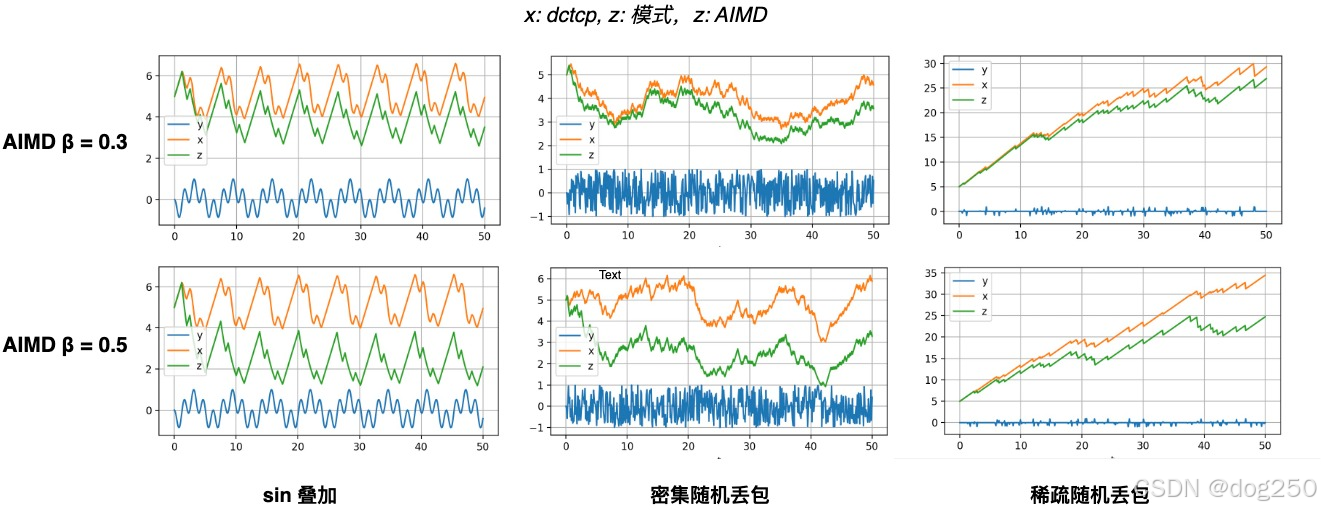dctcp 相比标准 aimd 如 reno,cubic 到底好在哪,理论上讲 dctcp 本质上也是 aimd 算法,但它的 cwnd 根据 mark rate 来实时缩放,而标准 reno/cubic 则一致缩放 β = 0.5(reno) or β = 0.3(cubic),直观上看 dctcp 是连续平滑的缩放,而 aimd 则是一瞬间缩放,这对随机丢包环境非常不抗造。
在非随机丢包的拥塞丢包场景,dctcp 对拥塞的敏感性要比 reno/cubic 强很多,它会按照 mark rate 来缓慢降 cwnd,并且在拥塞缓解时迅速感知,不必继续降 cwnd:
W = W − α 2 ⋅ W W=W-\dfrac{\alpha}{2}\cdot W W=W−2α⋅W
为此,我对 dctcp 做了如下的模拟:
d W d t = { 1 , y ≤ 0 − 0.5 ⋅ y ⋅ W , y > 0 \dfrac{dW}{dt} = \begin{cases} 1, & y \leq 0 \\ -0.5\cdot y\cdot W, & y \gt 0 \end{cases} dtdW={1,−0.5⋅y⋅W,y≤0y>0
而相应的 reno/cubic 过程则是:
d W d t = { 1 , y ≤ 0 − β ⋅ W , y > 0 \dfrac{dW}{dt} = \begin{cases} 1, & y \leq 0 \\ -\beta\cdot W, & y \gt 0 \end{cases} dtdW={1,−β⋅W,y≤0y>0
这就能绘制出经典的 tcp 锯齿了,如下图:
可以非常清晰得看出在连续拥塞和缓解(sin 函数模拟),密集随机丢包和稀疏随机丢包三种模式下,dctcp 均可获得更小的 cwnd 损失。
dctcp 这个收益难道来自算法的精妙吗?不!它来自 ecn 带来的更加确定的信息。
上图的代码如下:
#!/opt/homebrew/bin/python3 import sys import numpy as np import matplotlib.pyplot as plt import random type = "0" beta = 0.5 def dxdt(x, y, t): if y > 0: return - 0.5 * y * x else: return 1 def dzdt(z, y, t): if y > 0: return - beta * z else: return 1 def ydt(y, t): if type == "sin": return 0.5*(-np.cos(0.1*t) + np.cos(0.4*t)) elif type == "xishu": prob = random.random() if prob < 0.8: return 0 return 2*random.random() - 1 elif type == "miji": return 2*random.random() - 1 return 0 if len(sys.argv) < 3: sys.exit() type = sys.argv[1] beta = float(sys.argv[2]) t = np.linspace(0, 50, 500) x = np.zeros_like(t) y = np.zeros_like(t) z = np.zeros_like(t) x[0], z[0] = 5, 5 for i in range(1, len(t)): dt = t[i] - t[i - 1] dy = ydt(y[i - 1], i) dx = dxdt(x[i - 1], dy, t[i - 1]) dz = dzdt(z[i - 1], dy, t[i - 1]) x[i] = x[i - 1] + (dx) * dt z[i] = z[i - 1] + (dz) * dt y[i] = dy plt.plot(t, y, label='y') # mark rate < 1 plt.plot(t, x, label='x') # dctcp plt.plot(t, z, label='z') # reno/cubic plt.legend() plt.xlabel('t') plt.grid(True) plt.show() 浙江温州皮鞋湿,下雨进水不会胖。
